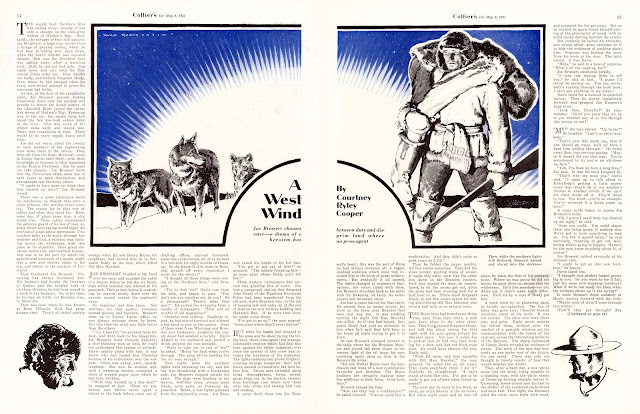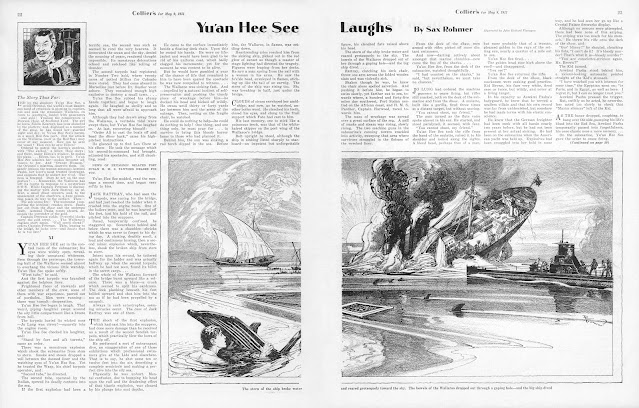EDIT: I've been looking at this magazine a little more closely lately and have been gathering existing scans of issues as well as scanning some new ones. Yoc over at the Digital Comics Museum informed me he wanted to put up a section for Ballyhoo and link my blog, so I'm taking the opportunity to get new links and images up for a post in need of repair. After the refurbished post, I'll add just a couple insights and some new issues.
An issue of a classic American magazine up for your enjoyment, Ballyhoo!
Ballyhoo v06n01 (1934-02.Dell)(Darwination-McCoy).cbr
Get the cover to cover scan here.
At the Internet Archive here.
Scan edits for the issue from the one and only McCoy.
Ballyhoo was the brainchild of editor Norman Anthony who had pitched the
idea to George Delacorte at Dell for a magazine without sponsors,
indeed for a magazine that that lampooned Madison avenue and the
burgeoning advertising industry. Anthony had been in humor magazines
for years and is remembered for always wanting to push the envelope.
He'd been an editor for Judge but felt that there was too much pressure
from advertisers about propriety. In his short run as editor for Life,
he radically altered the magazine, discarding much of the traditional
content. With Ballyhoo, he finally got the chance to really change the
mold of the American humor magazine
Here
is an article in Time from May 11, 1931, in which Delacorte expresses
his reservations about the "freshness" of the magazine (Anthony
supposedly tried to have some of the initial issue's 150,000 copy
pressing wrapped in cellophane, but I'm unsure if any issues were
actually shipped this way). Delacorte's reservations quickly
evaporated, I'm sure, as the first copy sold out quickly. The magazine
was a complete success, exploding in popularity. Theodore Peterson's
excellent 1964 book, Magazines in the Twentieth Century,
says, "Although the circulation figures are unreliable, the first issue
of 150,000 copies was said to have sold out in five days; the second
issue sold 450,000 copies, the third 675,000, and the fourth more than
1,000,000. In a few months circulation exceeded 2,000,000." Within a
couple years, the circulation would drop back down to about 300,000, but
it's 2 million plus circulation mark would not be passed until the 40s
with Life and Woman's Day. Advertisers soon pleaded for page space and
ads were introduced. It says something that at times it can be
difficult to tell between the real and the parody...
The rocketing onto the scene of this magazine seems unique in that it
begat a whole craze. Mimicking the readily identifiable patchwork
colors of the cover design, clothing makers rushed out dresses, ties,
scarves, etc. with the Ballyhoo theme. A book from Simon and Schuster,
greeting cards, games, songs and more were produced on the theme, and
Anthony even wrote a musical show titled Ballyhoo (which introduced a
youn Bob Hope to the stage). A neat piece of trivia for you pinball
fans like me out there, the first pinball game had a Ballyhoo theme.
You can see it here
if you scroll half way down the screen. I can't tell for sure, but it
looks like the Bally game company stuck with half of the name of this
first machine. And all this talk of faddishness and cultural saturation
leads nicely into our covergirl or cover woman, rather, as labeling Mae
West as anything but just won't do.
A few nice pics of West, my kind of gal. This first one (a pic of Mae
on trial for obscenity for her Broadway show "Sex" in 1927) is taken
from a nice review of She Done Him Wrong (1933) over at Lolita's classics
(she's also got a review of I'm No Angel also from the year previous
the publication of this Mae West issue). The other two, more in a
pin-up vein - Mae West had curves in all those places flappers didn't.
In the issue, you get a sense of how big of a sensation West was. She was just everywhere. Her up-front sexuality and disarming wit took the nation by storm and single-handedly had decency groups up-in-arms. And like most fads, perhaps seeing Mae everywhere did get tiresome.
On the other hand, what's not to like? The gag men bust out the breast
jokes en masse for this issue, bawdy humor being a specialty of
Ballyhoo . The crude audacity of Ballyhoo is a great surprise, but I
think it's done with such a wink and a smile that they were able to get
away with much more than other magazines might have.
Steady, men, steady.
Oh my...
A hallmark Ballyhoo two page spread style of five toons with a big one in the center, notice the Minnie parody in the bottom left.
Ralph Fuller causing a splash at the aquarium
And also tonight, a bonus issue from the following month, March 1934 -
The Clean Number. Involving many plumber's jokes, a lost genre of dirty
joke? Russell Patterson cover.
Ballyhoo v06n02 (1934-03. Dell)(D&M).cbr
The scan's here.
Plumber's jokes as noted artists (Picasso, Brinkley, McCay) might do them:
or the Hollywood take
The trophies, C.W. Anderson
Big thanks to scanmeister McCoy for the edit work on both of tonight's issues.
EDIT: New thoughts, new scans below
So, I've been getting the handful of Ballyhoos I've done up at the Internet Archive (there's a link to my shelf on the right hand side of this blog) and also looking more closely at this era of humor magazine with magazines like KooKoo, Wild Cherries, Smokehouse Monthly and others.
With Ballyhoo exploding to a circulation of 2 million almost overnight, you can see how competitors would hope to hop on the train. Will Straw has a neat blog post where he posts a lot of these magazines covers here in a post titled United States : The New York Humour Magazine Wave of 1931-1932. Featured are covers for Ballyhoo, Hooey, Boloney, Hokum, Bunk, Slapstick, Hullaballoo, BLAH, and BUSHWA. There were many more like them. In the depths of the depression, people needed a laugh. You can be assured, though, most imitators lost money hoping to duplicate Ballyhoo's novelty and success, but that didn't deter them from trying (and some of these magazines are very good).
One I worked with recently while we're at it, excellent cover design. A collaboration between Joey Burten and Harry Donenfeld which lasted I believe three issues, here's the second, not a great magazine but sort of an interesting aesthetic.
.cbr here.
Not a full issue, and quick work from found photos, but another wraparound cover from Bunk v01n01 from Clayton in 1932
Of course, it seems Ballyhoo is the trendsetter here, as some kind soul has put the first issue, August 1931, up at the IA. The wraparound cover boasts of its freshness and editor Norman Anthony.
But speaking of fresh, I leave you today with a fresh Ballyhoo scan. I've got a few more to do and a couple I haven't shared on my blog yet. I've also gathered what issues have been scanned from the Internet Archive (huge props to the unsung IA scanners out there, some of my favorite scanners) and put them in a folder here, as we are starting to get a better record of this fun sensation of a magazine. Times were hard in The Great Depression and some of the artists from the slicks were taking work where they could get it. Magazines like Ballyhoo were able to offer a paycheck.
Thanks for the edits on this last one to DaveH, a new partner at Darwin's Free Press who has been helping me with some goldenage comic edits and who will be working with me on some magazines as well. Here's Ballyhoo from March 1932 with an Ed Graham cover. Sadly, the issue is missing four pages, but that's pretty common for these Ballyhoos. People pulled out the gags on the big slick pages (not to mention there might be some nice nudie art that deserved saving, I understand but leave my copies alone you dirty boys!)
.cbr here.
Next time at Darwination Scans, the Columbus Sunday Star, wild, man, wild.



















.jpg)








